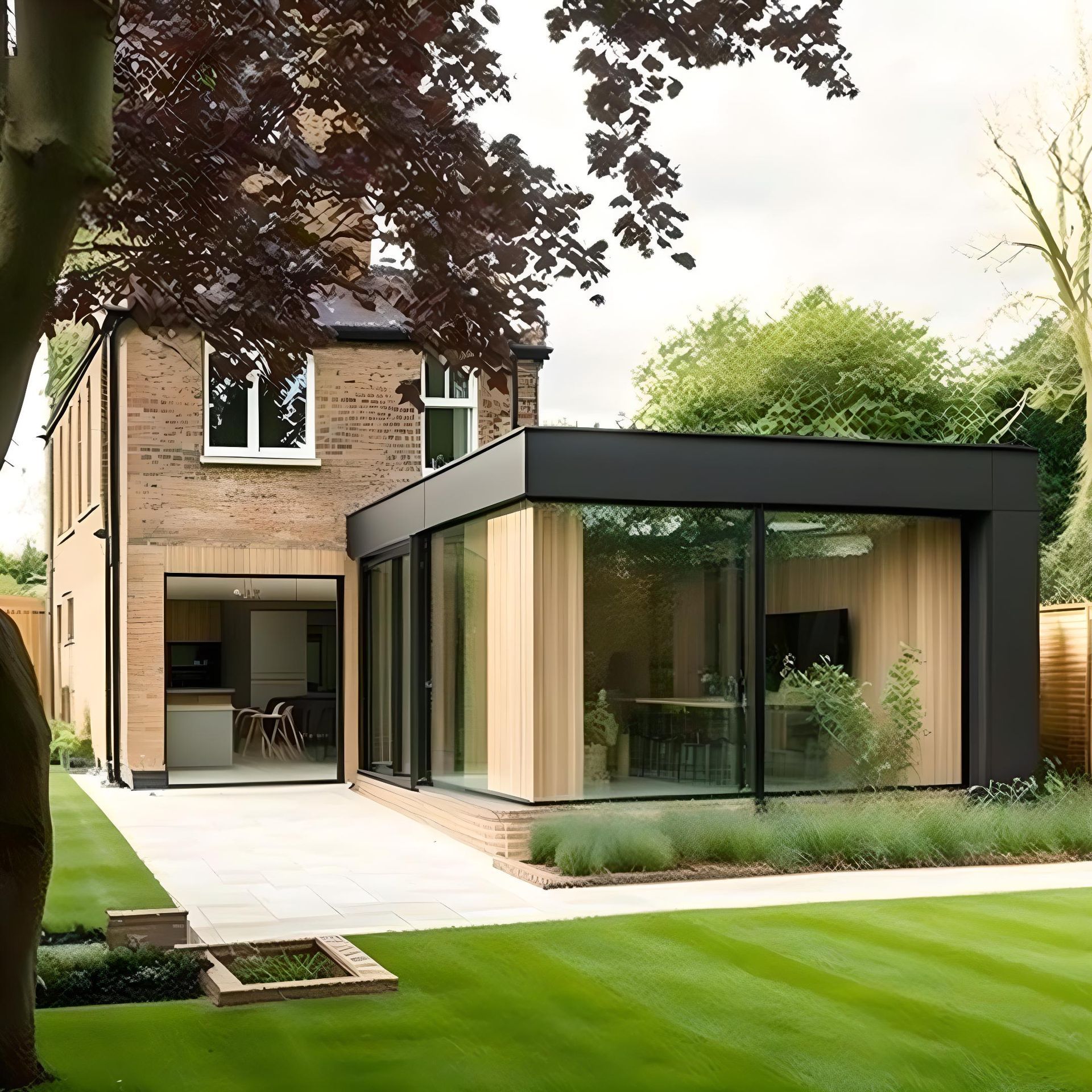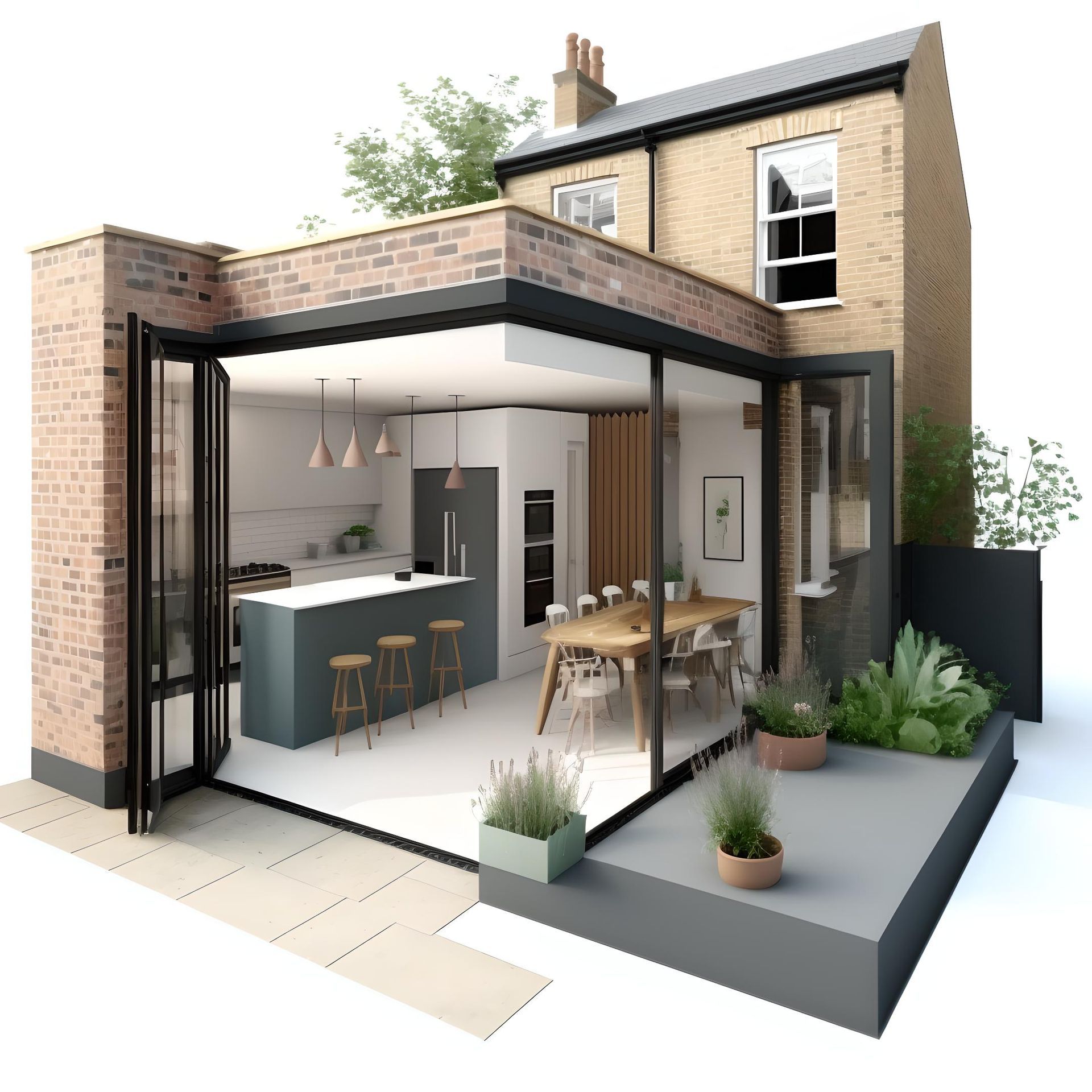Why You Should Consider Air Conditioning for Your House Extension: Benefits, Types, and Costs
If you’re planning a house extension of any kind, you may or may not have considered air conditioning. However, with summer temperatures in the UK hitting 40 degrees in 2022 and with average temperatures soaring, it could be prudent!
Only
0.5% of homes in the UK come equipped with air-con, and other countries criticise us for that – you could even say ridicule.
After all, air con is not just nice to have in such situations, but it’s also beneficial for health and supports activities like working at home. Anyone working from home in the 40-degree heat of the 2022 heatwave would testify that a fan simply doesn’t cut it.
As demand for air-con rises, fitting it in your home might be a wise choice – extensions provide an ideal opportunity.
So, should you consider installing air con with your house extension? And how much does air con cost?
Air con for house extensions
Installing air con is certainly an option if you’re building any of the following types of house extensions:
- Side-return extension
- Rear extension
- Any sort of single or two-storey extension
- Any type of loft conversion (velux, dormer and Mansard)
Air con is pretty simple to install into a new or existing room, and the costs of a new installation are less than those of a retrospective installation.
Since air con involves making alterations to the walls, it’s easier to install as part of a house extension. In short, if you’re planning a house extension, it’s an ideal time to consider air con.
Benefits of air conditioning systems
So, why would you want to install an air conditioning system anyway? There are some obvious benefits – like cooling the home – and some less obvious benefits – like purifying the air.
Cooling
First and foremost, air conditioning systems provide a comfortable indoor environment by regulating temperatures and humidity levels. While this isn’t so much of a priority in the UK as in other countries, summers here are getting hotter, and extreme heat waves seem inevitable.
Some homes can get unpleasantly hot, making sleep and work difficult. Office workplaces come equipped with air-con for a reason (and it’s a legal requirement in many cases). Installing an air con unit improves quality of life in the heat, which is becoming all the more common.
In the UK, we’ve relied on fans – but they don’t cut it in extreme heat. Freestanding air con units are fine, but are unsightly, inefficient, and aren’t effective for larger rooms. Permanent air con installations are becoming much more popular.
Heating
Many people assume air con is only for cooling, but that’s not the case. Modern air con units are typically capable of reversing their action to heat the air rather than cool it.
Air con-powered heating is effective in hard-to-heat rooms, such as open-plan rooms where radiators fail to warm the innermost portions of the room. Instead, they circulate the air, resulting in an evenly-heated room.
Additionally, air con heating means saving space occupied by radiators. Depending on your heating system, air-con can even be more energy efficient than gas boilers or electric heating, meaning lower energy bills. They can also supplement other forms of heating from radiators or underfloor heating.
Health
Air quality is a significant health issue in cities and next to busy roads. Modern air con units are built to purify the air in addition to regulating temperature.
Air conditioning systems are often equipped with air filters that improve indoor air quality by filtering out dust, allergens, and other pollutants. These are highly effective, as they completely circulate air while purifying it.
Modern air con units also regulate humidity levels, which can prevent the growth of mould and mildew – perfect for damp-prone homes or when inhabitants suffer from asthma or allergies like hay fever.
Home value
Installing air conditioning in one or more rooms is sure to perk buyer interest when you come to sell your home.
Demand for air con is increasing rapidly, and savvy homeowners can take advantage of this to increase the value of their homes compared to similar-priced properties in the area.
An air-conditioned bedroom or work area is an attractive proposition for buyers.
Planning Permission for air con units
Since air con units require work to the wall(s) and are fitted to the exterior and interior of a home, they must adhere to certain rules and regulations.
Externally fitted air conditioning units must meet certain specifications to avoid the need for Planning Permission – particularly concerning size and positioning. However, most compact modern air-con units nearly always fall under Permitted Development, meaning that Planning Permission is not required.
To fall under Permitted Development, the external component of the air con unit must meet the following specifications:
- Must be 0.6m³ or smaller
- Must be located over a metre away from any property boundaries
- Must be more than a metre away from the edge of a flat roof
- Can’t be fitted on a pitched roof
These rules don’t automatically apply to properties on designated land, which include:
- Conservation Areas
- Areas of Outstanding Natural Beauty
- National Parks
- World Heritage Sites
Local councils may also remove some or all Permitted Development rights from a certain area to protect it. It’s always sensible to ask your local authority before fitting an air con unit. Finally, you’ll need Listed Building Consent if you own a Listed Building.
For more information on Permitted Development, head here.
Air con and your neighbours
It’s essential to bear in mind that air con units can be noisy and that the external portion of the unit emits hot or cold air depending on whether you’re cooling or heating your home.
If you install air con properly under Permitted Development (over 1m away from the boundary), then it shouldn’t be too close to your boundary – and, therefore, your neighbours.
However, it’s feasible that they might complain about excessive noise and hot or cold air emitted by the unit. This could be a problem down the line.
Also, if the wall you intend to install the unit on is a shared Party Wall, then you’ll need to consider the Party Wall Act.
Types of air conditioning systems
There’s more than one format and style of air conditioning system. Here are the three main types of air conditioning systems you can choose from:
1. Split air conditioning systems
Split air conditioning systems are the most common type of air conditioning system used in domestic properties. If you need air con for just one part of your home, e.g. a bedroom, then consider a split air conditioning system. They consist of two units; an indoor unit, and an outdoor unit.
The indoor unit is mounted on the wall or ceiling of the room and delivers air, while the outdoor unit is installed outside the house.
The indoor unit contains the evaporator coil, which cools the air by absorbing heat from the indoor air. The outdoor unit contains the compressor, which compresses the refrigerant gas and releases the heat absorbed from the indoor air, which is expelled outside.
Split air conditioning systems are relatively easy to install and operate, making them popular for house extensions. They’re ideal for single-room installations.
2. Multi-split air conditioning systems
Multi-split air conditioning systems are similar to split systems, but they can cool multiple rooms using a single outdoor unit.
The indoor units can be installed in different rooms, and you can usually control each unit separately.
Each one is connected to the same outdoor unit, which cools air from all connected rooms. In some cases, one external unit can support as many as 10 internal units.
3. Ducted air conditioning systems
Ducted air conditioning systems are suitable for larger house installations, as they can cool many rooms simultaneously. They consist of an outdoor unit, an indoor unit, and ducts that distribute cool air to different rooms. A ducted installation is worthy of consideration if you want to air-con your entire home.
Here, the indoor unit is usually installed in the ceiling, and the ducts are hidden in the ceiling or walls. The cool air is distributed through vents installed in each room.
Due to their size and complexity, ducted setups are more expensive than split systems. They’re becoming more popular for large-scale renovation projects and new builds.
Choosing the right air conditioning system
When choosing an air conditioning system for your house extension, there are several factors to consider, including the size of the room, the number of rooms to be cooled, the location of the outdoor unit, and your budget.
Requirements
House extensions provide an ideal opportunity to fit air con into a new or existing room. In this case, a slimline split system delivers performance without altering other rooms.
For example, if the extension involves building or altering an existing external wall, you can install air con simultaneously.
Budget
A simple split system provides high-performance air con to one room, such as a bedroom or living room. Compact split air con systems can cost as little as £2,000, and installation costs may be reduced when fitting one in a new wall.
Multi-split systems for multiple rooms will cost anything between £2,000 and £10,000 or more, depending on how many rooms you want to cover.
Then, a sophisticated ducted system for a major extension, home renovation project or new build will likely cost north of £10,000.
Location and format
As mentioned, Planning Permission and Permitted Development come into play when installing air conditioning units.
You’ll likely need to consider the size and location of the external unit, especially if it’s likely to fall near a boundary. It’s best to avoid close contact with any neighbours.
Summary: Ultimate guide to air conditioning for house extensions
Air conditioning is gaining popularity in the UK. So if you’re planning a house extension or loft conversion, it could be worth considering installing air-con simultaneously.
Air con units start from £1,000 to £2,000 for simple split systems for one room and rise to £10,000 for complex multi-room systems. It’s an investment, but as the mercury rises, demand for homes that can cool
and
heat efficiently increases.
Fast Plans are experts at designing new interior spaces and provide professional drawings for loft conversions and house extensions. We provide measured property surveys, Planning Permission and Permitted Development drawings and structural surveys with unlimited revisions.
Contact us here
- our friendly team is ready to discuss your project with you.
Get in touch
It doesn't matter how large or small your project is, or how early in the planning process you are. We can help.
With our vast experience, we deliver both a refreshingly honest approach and great value for money; after all, when it comes to projects as crucial as these, you want to get it right the first time! Our team of experienced and highly qualified architects and designers can bring your home improvement dreams to life.
Request a FREE consultation with our design team
Request your FREE no-obligation proposal

Schedule a Call/Get in Touch Form
We will get back to you as soon as possible.
Please try again later.
Related posts
Our fast and seamless design and planning services have helped thousands of homeowners maximise their living space.
H: M - F / 8am - 5.30pm
Take a Look Around
Service Areas
Social
Fast Plans | All Rights Reserved.


